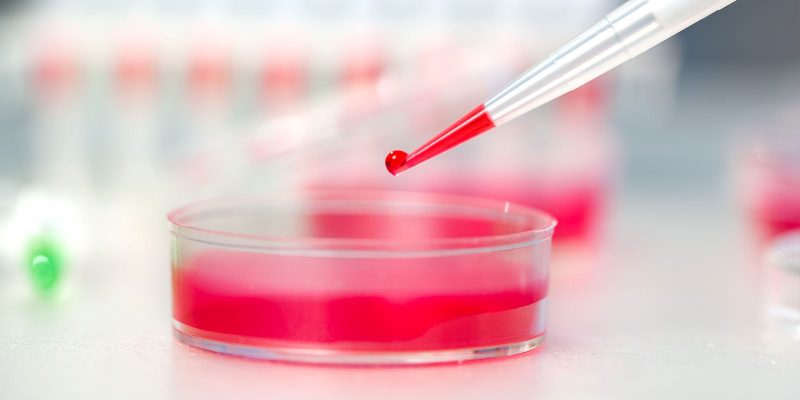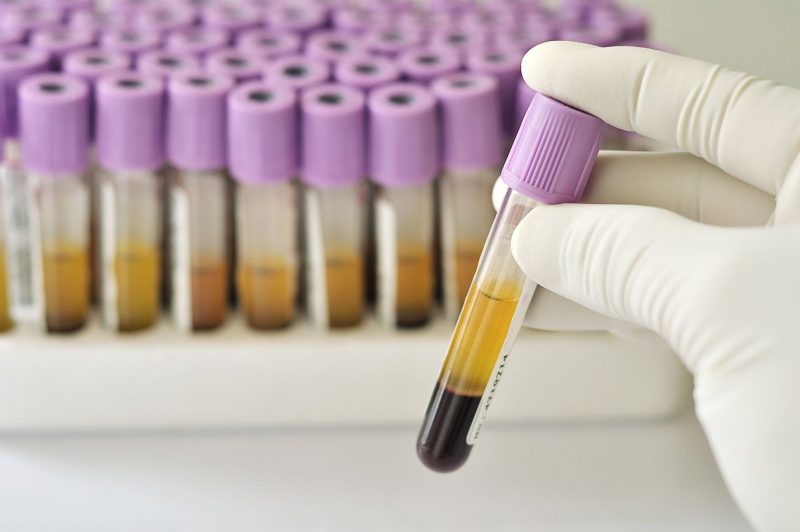One of the most dangerous diseases on earth is diabetes. It still cannot be completely cured, but can be slowed down in its destructive development if measures are taken on time. Detect a hidden disease in its very embryo allows the analysis of glycated hemoglobin.
Material Content:
What is glycated hemoglobin?

Probably many have heard about hemoglobin, and even tested more than once. And what is glycated hemoglobin? Hemoglobin itself is a component of red blood cells that deliver oxygen to cells and remove carbon dioxide from them. And when sugar enters the red blood cell through its membrane, a reaction occurs between the amino acid and sugar. What results from this reaction is glycated hemoglobin. A glycated hemoglobin test is very important in diagnosing latent diabetes.
What does a blood test for glycated hemoglobin show?
A glycated hemoglobin test is an indicator of blood sugar over a period of time. Red blood cells live and fulfill their purpose for about 4 months. During this time, hemoglobin is in a stable state. And then the red blood cells break down. Glycohemoglobin, as well as its free form, undergoes a change. After this, glucose and the final breakdown product of hemoglobin (bilirubin) no longer bind to each other. Glycohemoglobin is divided into three main forms: HbA1a; HbA1b; HbA1c. For analysis, the third form is important. It indicates how correctly the process of hydrocarbon exchange occurs. And if the level of glycated hemoglobin goes off scale, then the blood sugar level is also elevated.
As a result, the analysis will show:
- the possibility of developing hypoglycemia;
- the initial stage of diabetes;
- diabetes treatment results;
- problems with various internal organs.
The timely identified problem allows you to develop measures to prevent the development of diabetes. And it is also important as a result of the analysis to understand how adequate and successful the prescribed treatment is for a problem that has already been identified.
The rate of glycated hemoglobin:
Glycated hemoglobin, the norm of this substance is calculated as a percentage of the total hemoglobin volume. It is used as a marker to determine the risk of diabetes. The marker shows even the smallest problem, the initial stage of the disease, when a person still does not feel any signs.

An average glycogemoglobin of 4-6 percent indicates that there is no reason for concern, everything is normal. When the indicator reaches 7, then this is called "prediabetes." When 7-9 percent is an ailment in its very development (subcompensated) and may soon lead to complications. And when over 10 - this, alas, is such a stage of the ailment when irreversible changes in health have occurred against the background of diabetes. The norm indicator depends on the patient's age, gender and other factors. For example, for those whose age is 30-50 years old, up to 7 percent is also the norm. And who is over fifty, then generally should be at least 7 percent normal.
It is interesting: the norm of hemoglobin in men by age in the table
For men
It is common for men to have a higher hemoglobin rate than women.
The normal percentage of HbA1c is as follows:
- under the age of 30 years - up to 5.5 percent is considered a normal indicator;
- up to 50 years - it is normal to have up to 6.5 percent;
- if older than 50 years - the norm is 7 percent.
If young people showed 7 percent, then this is type 1 diabetes, over 7 percent - type 2 diabetes.
For women
In women, the percentage of hemoglobin is traditionally slightly lower than in the stronger sex.

And the percentage of normal HbA1c in percent is as follows:
- under the age of 30 years - up to 5 percent is considered a normal indicator;
- up to 50 years - it is normal to have up to 7 percent;
- if older than 50 years - the norm is at least 7 percent.
With an increased indication of HbA1c, hyperglycemia.
Children's norms
In children under the age of 16 years, the hemoglobin level in the normal range is from 3.3 to 5.5 percent.
In an infant of the first months of life, hemoglobin is increased, but this is within acceptable limits, there is nothing to worry about, and it should be so. By about a year of life, everything is back to normal.
If the child has diabetes, measures should be taken to ensure that the indicator does not exceed 7 percent.
During pregnancy
When carrying a fetus in a future mother, the level of glycated hemoglobin should be higher than normal. This is normal. The kid needs strength for development. Sometimes a young woman's indicator reaches 6.5 percent - this is also considered the norm. And for a future mother older than 30 years, 7.5 percent will also be within the limit.
With a high glycogemoglobin content, the child risks being born too large, more than 4 kilograms. This will complicate the birth of such a hero.

Worse, if the hemoglobin level drops, then this has two dangerous consequences:
- developmental delay of the baby;
- premature birth.
That is why all expectant mothers periodically test for HbA1c during the crucial period of their lives. This is done at least once a month and a half. If any abnormalities are found, the doctor will prescribe a special diet or medication.
Standards for patients with diabetes
With a diagnosis and developing diabetes, glycated hemoglobin changes. Some patients think why they should take this test, if it is already clear that glucose is not normal.In fact, a glycated hemoglobin test allows you to better control your glucose level and adjust your treatment in time to avoid complications.
The average figure for patients is 8 percent. But younger patients should strive for 6.5 percent so that there are no complications.
With an indicator of 8 percent, it is worth immediately adjusting the treatment to restore normal processes. And who has reached 12 percent, he urgently needs hospitalization.
But a sharp decrease in glycogemoglobin is fraught with the fact that kidneys and eyes can suffer. Normal is a decrease to 1-1.5 percent per year.
Causes and consequences of elevated and decreased glycated hemoglobin levels
Not only diabetes itself, but also many other factors, and sometimes complex reasons, can lead to elevated levels of glycogemoglobin.

This is facilitated by:
- low mobility, sedentary lifestyle;
- age - the risk increases after 45 years, so every three years you need to take the test as a prophylaxis;
- polycystic ovary;
- the birth of a baby weighing more than 4 kilograms;
- intestinal obstruction;
- cancer;
- excess vitamin B;
- iron deficiency;
- splenectomy;
- thick blood;
- stress, depression;
- pulmonary failure;
- heart disease
- hemoglobinemia.
The consequence, as a rule, is the development of diabetes. To reduce the rate, you should take the prescribed sugar-lowering drugs and insulin injections, adhere to a low-carbon diet, and properly regulate sleep and rest. Regular exercise also helps.
It would be wrong to assume that only elevated glycogemoglobin is dangerous. No less fraught with its reduced state. This also happens.
And the reasons for the reduced rate may be;
- blood loss;
- anemia;
- stress
- a decrease in glucose, including due to sugar-lowering drugs or a strict low-carb diet;
- adrenal insufficiency;
- hereditary reasons.
As a result, this leads to the fact that the organs are undernourished, especially the brain suffers. Therefore, there may be dizziness, headache, fainting. It can also be manifested by visual impairment, rapid fatigue, drowsiness, neurological disorders. In severe manifestations of the disease, with a sharp decrease in glucose levels, a stroke and coma can even occur. To help raise the percentage of glycogemoglobin, just drink sweet tea, eat candy or a piece of sugar.
Even healthy people need to take a test to check glycogemoglobin at least once a year, and for those with diabetes - once every three months.
How to get tested for glycated hemoglobin?
The analysis must be passed according to all the rules, otherwise the results will be distorted. A test is taken at any time. And it is believed that eating before passing the test has no effect on the result. Nevertheless, there is an opinion that the test should be taken ideally in the morning and on an empty stomach. Blood is taken from a vein, but also from a finger.

Half an hour before the test, you need to give up smoking, avoid stressful situations. But to use medicines on the eve of the analysis is quite acceptable. This will not affect the result.
Another important tip: taking a test is best in a government agency. There the results will always be accurate. But if you had to do this in paid clinics, you need to choose those who have a longstanding reputation.
The result of the study is usually obtained on the third day, and the cost of analysis in paid clinics depends on the quality of the laboratory.
An analysis should be taken regularly for preventive purposes.
And it is worth taking the test unscheduled if:
- unexplained and quick weight gain occurs;
- thirsty;
- wounds do not heal as quickly as always;
- strange fatigue and drowsiness appeared;
- frequent urination;
- "Naughty" heart and blood pressure;
- often nausea, abdominal pain.
All this can be a consequence of the imbalance of glycogemoglobin and a harbinger of the disease. More often to take tests, at least three times a year, should also be for those who had diabetics in the family.












